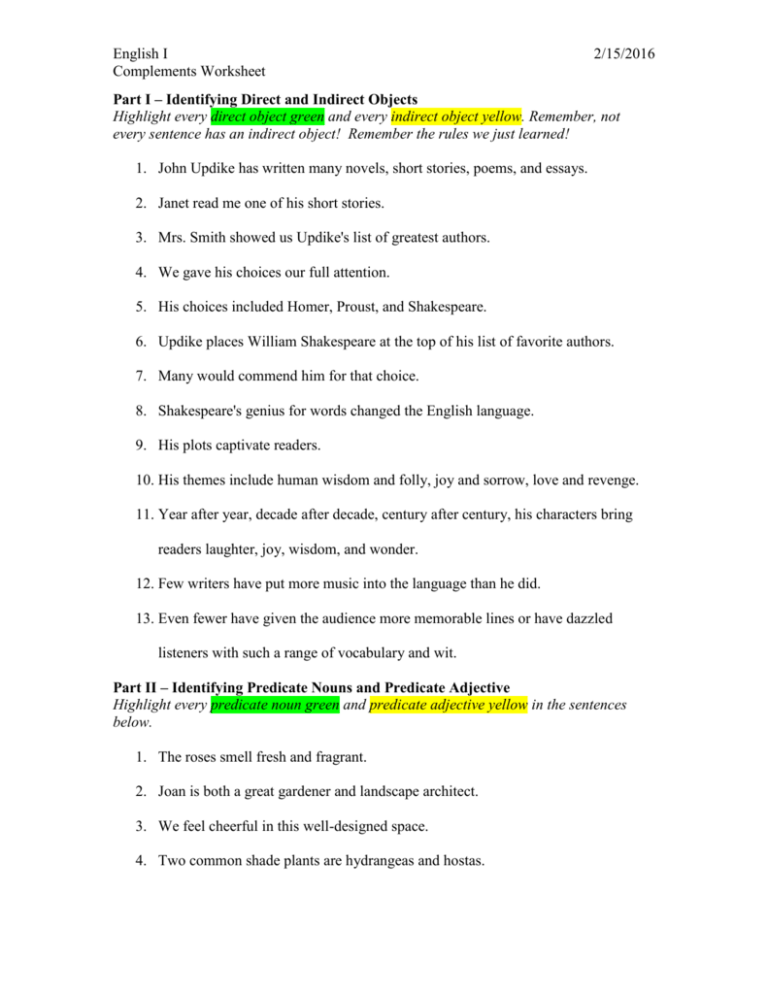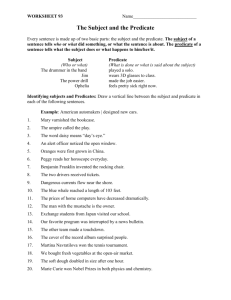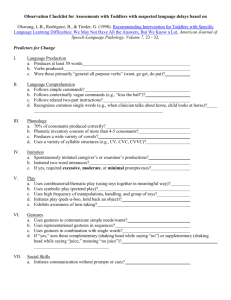Part I – Identifying Direct and Indirect Objects
advertisement

English I Complements Worksheet 2/15/2016 Part I – Identifying Direct and Indirect Objects Highlight every direct object green and every indirect object yellow. Remember, not every sentence has an indirect object! Remember the rules we just learned! 1. John Updike has written many novels, short stories, poems, and essays. 2. Janet read me one of his short stories. 3. Mrs. Smith showed us Updike's list of greatest authors. 4. We gave his choices our full attention. 5. His choices included Homer, Proust, and Shakespeare. 6. Updike places William Shakespeare at the top of his list of favorite authors. 7. Many would commend him for that choice. 8. Shakespeare's genius for words changed the English language. 9. His plots captivate readers. 10. His themes include human wisdom and folly, joy and sorrow, love and revenge. 11. Year after year, decade after decade, century after century, his characters bring readers laughter, joy, wisdom, and wonder. 12. Few writers have put more music into the language than he did. 13. Even fewer have given the audience more memorable lines or have dazzled listeners with such a range of vocabulary and wit. Part II – Identifying Predicate Nouns and Predicate Adjective Highlight every predicate noun green and predicate adjective yellow in the sentences below. 1. The roses smell fresh and fragrant. 2. Joan is both a great gardener and landscape architect. 3. We feel cheerful in this well-designed space. 4. Two common shade plants are hydrangeas and hostas. English I Complements Worksheet 2/15/2016 5. Fresh, edible flowers look spectacular on a salad or cake. Part III – Mixing it Up! In each sentence below, identify the italicized word or words. After the sentence, write DO (direct object), IO (indirect object), PA (predicate adjective), or PN (predicate noun), depending on what the italicized word is in the sentence. 1. Many people use their hands in conversation. 2. At times, such gestures may seem silly or unnecessary. 3. At other times, such gestures appear meaningful. 4. Patrick read me an article on a recent scientific study about using hands during speech. 5. People in the study were either blind or sighted. 6. Blind children used gestures as often as sighted children did. 7. With equal frequency, people gestured their ideas to both blind and sighted listeners. 8. This study gives the world a new view of gestures. 9. Gestures may be a form of thought or a way of thinking. 10. Of course, current theories are still hypothetical. ~~ Answers on the next page ~~ English I Complements Worksheet Part I Answers 1. DO: novels; short stories; poems; essays 2. IO: me DO: one 3. IO: us DO: list 4. IO: choices DO: attention 5. DO: Homer; Proust; Shakespeare 6. DO: William Shakespeare 7. DO: hum 8. DO: language 9. DO: readers 10. DO: wisdom; folly; joy; sorrow; love; revenge 11. IO: readers DO: laughter; joy; wisdom; wonder 12. DO: music 13. IO: audience DO: lines; listeners Part II Answers 1. PA: fresh; fragrant 2. PN: gardener; landscape architect 3. PA: cheerful 4. PN: hydrangeas; hostas 5. PA: spectacular Part III Answers 1. hands: DO 2. silly: PA unnecessary: PA 2/15/2016 English I Complements Worksheet 3. meaningful: PA 4. me: IO article: DO 5. blind: PA sighted: PA 6. gestures: DO 7. ideas: DO 8. world: IO view: DO 9. form: PN way: PN 10. hypothetical: PA 2/15/2016







